by Mary Howard

On 5/13/21, we welcomed a familiar face to the #G2Great guest host seat when Dr. Sonja Cherry-Paul returned to share her much anticipated new book: Stamped (For Kids): Racism, Antiracism, and You (2021, Little, Brown and Company). Sonja and Dana Johansen previously co-hosted on 8/8/19 for Breathing New Life Into Book Clubs: A Practical Guide for Teachers (2019, Heinemann). We couldn’t wait to soak in Sonja’s wisdom yet again, especially given the critical need for deep discussions about racism, antiracism and actionable steps that each of us could take.
Stamped (For Kids) joins a family of three incredible books. It is described as an “adaptation” based on the first of this book family by Dr. Ibram X. Kendi; Stamped from the Beginning: The Definitive History of Racist Ideas in America. This is quite an accomplishment considering Sonja beautifully transforms nearly 600 pages into less than 200. Dr. Jason Reynolds wrote an adaptation for teens in Racism, Antiracism and You while Sonja’s book focuses on ages 7-12, although we are already seeing that it is also having an impact on children beyond and even below this age range.
My personal copy of Stamped arrived two days before our chat. It’s the first time I recall being so engrossed in a book that I read from cover to cover in one day, barely coming up for air followed by a reread the next day.
Yes, Stamped (For Kids) is that captivating.
With each page, I grew more certain that it would have a lingering impact for years to come. But then, why take my word?
“This book is going to change the world and shake things up in the best possible way.”
Julia Torres quoted above during a Stamped (For Kids) Webinar
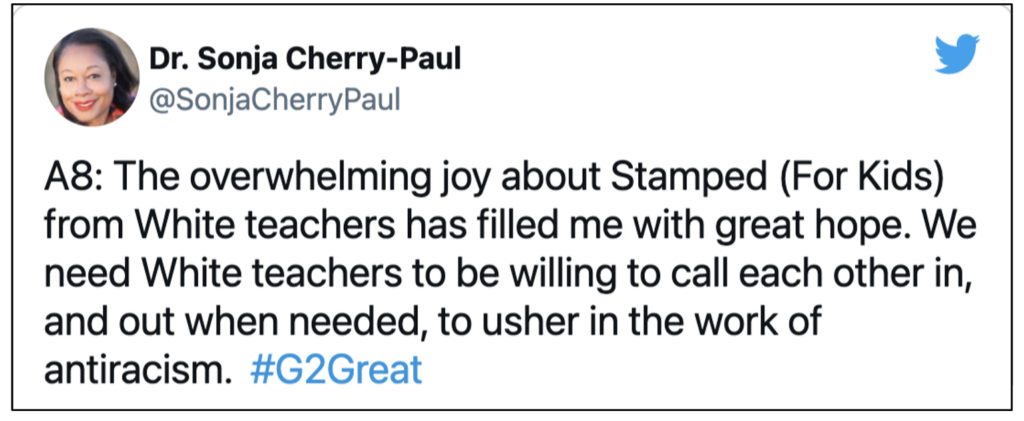
As I read, I was struck by the student-centered design that included twenty-four short chapters divided into historical time frames with reflections expertly scattered across the pages lifted by the exquisite art of Rachelle Baker. Add to this, the text resources with a Timeline of Key Moments in American History, Glossary, and further reading for educators and it’s clear that Sonja’s gift between two covers will most certainly linger long after reading and “change the world” for many years to come.
Through this thoughtful design, I envisioned the amazing BIG conversations Stamped would provoke. I knew it was written for kids, but as an adult reader I realized that this design also offers teachers a gentle conversational nudge. One cannot read Stamped without recognizing that this dialogue will likely be uncomfortable for many educators, particularly white teachers like myself. Sonja wisely avoids a rigid “lesson plan” that may discourage teachers to draw from in-the-moment opportunities that arise in the course of reading. Instead, she adds “Let’s Pause/Let’s Unpause” thinking boxes at just right points across the chapters that feel like an “invitation” while leaving room for teachers to trust their instincts and what students bring to the discussion table.
In the opening paragraph of Stamped, Sonja talks directly to the “FOR KIDS” of this book, acknowledging that they may wonder what learning about people and events across history has to do with their lives. As a child, this question often crossed my mind, but my thoughts quickly turned to those who still carry reservations about teaching the history of racism even now. After reading Stamped, I am confident that Sonja’s kind and supportive voice will dramatically reduce the reservations of many teachers but know that we have a long way to go to change this perception for ALL.
When authors host our #G2great chat, we invite them to respond to three questions about their book to provide insight that adds to our understandings from the author’s perspective. So, let’s pause to look at Stamped (For Kids) from Sonja’s wise eyes:
What motivated you to write this book? What impact did you hope that it would have in the professional world?
I thought about the power and potential that Stamped For Kids could have in the lives of young people who would no longer have to wait for their teachers to get comfortable teaching about race and racism. Students can read SFK and access the information they need to think about the kind of choices they’d like to make in their lives. I hope educators will embrace SFK and will make it a core part of their curriculum. Because students will read this book and will start to show up in their classrooms ready to question text books, curriculums, assignments, and teaching that presents white-washed version of history. Students will show up ready to challenge racist ideas with antiracist ones.
Why are Sonja’s words above especially relevant? For me, it’s her deep belief in providing a support reference that could remove barriers of discomfort so that our children “no longer have to wait for their teachers to get comfortable teaching about race and racism.” The sense of urgency in Sonja’s words drew me back to a quote on page 3 that we shared early in the chat:

This quote was directly followed by Sonja’s use of “rope” as a metaphor to think about racism and antiracism. I have read this description repeatedly, but it was listening to Ibram X. Kendi read it aloud in a 5/10/21 live webinar as Sonja’s face lit up with joy that I will forever hold in my heart. Listen to Dr. Kendi read at marker 27:00 in this webinar recording by #LBYRExtraCredit Presents: Stamped (For Kids) with Ibram X.Kendi, Sonja Cherry-Paul and Julia Torres (The “rope” metaphor reappears in the book).
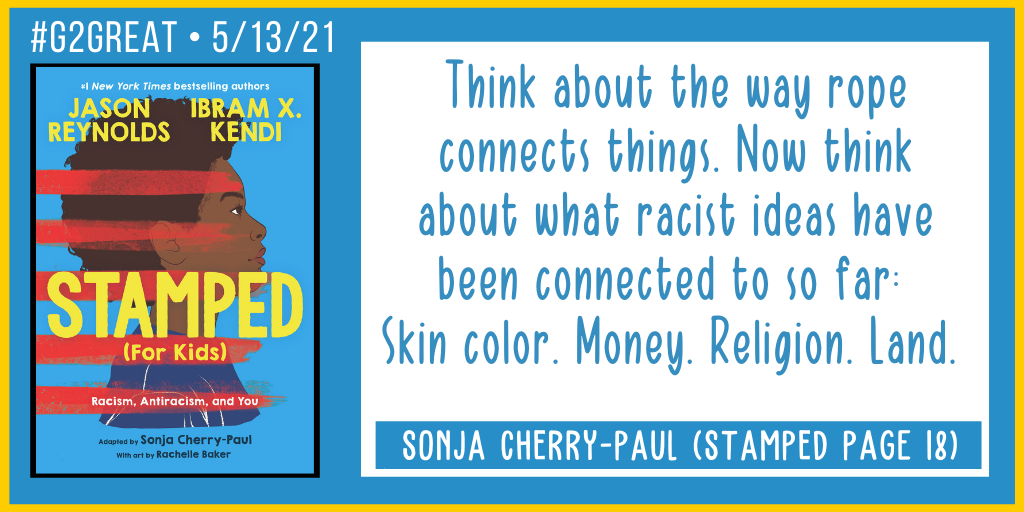
In twenty-four chapters, Sonja gives us the history of racism and antiracism spanning from 1415 to the present with events and people including names I was familiar with and many I was not. I learned about people who were both racists, those who were antiracists and even some who purportedly supported antiracist ideals while racist actions were in conflict with their words. I learned about writer’s musicians, authors, performers and artists and as a long-time hip hop lover, I was delighted to discover music I had missed by some of my favorite artists like James Brown’s “Say It Loud – I’m Black and I’m Proud” and Queen Latifah’s “Ladies First” that now have a place of honor on my favorites list.
As I read, I was saddened to realize how few of these events and people are taught in schools today, just as I never learned them in my own schooling that began in 1955. Knowing that professional impact is limited without that knowledge, I thought about our educational obsession for reducing Black History to a mere blip on the school calendar radar screen with a short list of names often used for fill-in-the-blank activities. As I type, I glance at Sonja’s book filled with history at my fingertips. I think about the disservice we do to children and adults who teach and love them if we don’t know that history – history that continues to have a stranglehold on our world.
This seems like a fitting time to share Sonja’s reflections on our second question:
What is a message from the heart you would like for every teacher to keep in mind?
Please keep in mind two powerful lenses to use when teaching about race and racism. 1) Affirmation. Even when teaching about the violent history of racism in the United States it is essential to affirm racial and cultural identities of those who have been most impacted by racism: Black and Brown people. In a country that is filled with anti-Blackness students need educators to affirm Blackness. 2) Awareness. Tell and teach the truth. Help students to identify the ways racism works beyond individual acts of hate; that racism is not isolated, but endemic. Help students see how racism functions systemically in all of the nation’s institutions, so that they can develop tools to identify it in their lives and also to disrupt it.
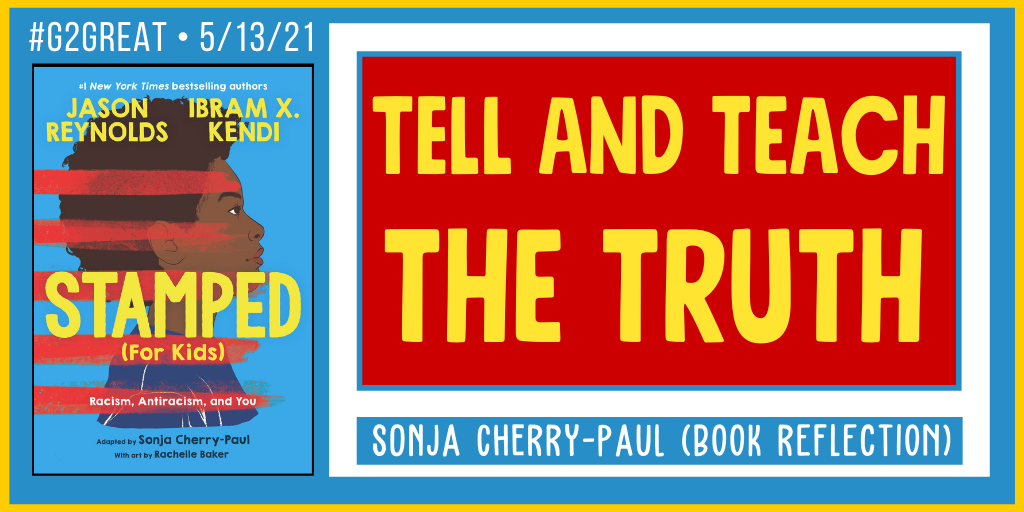
During #G2great chat, Sonja told the truth we can use to teach in tweet after tweet:
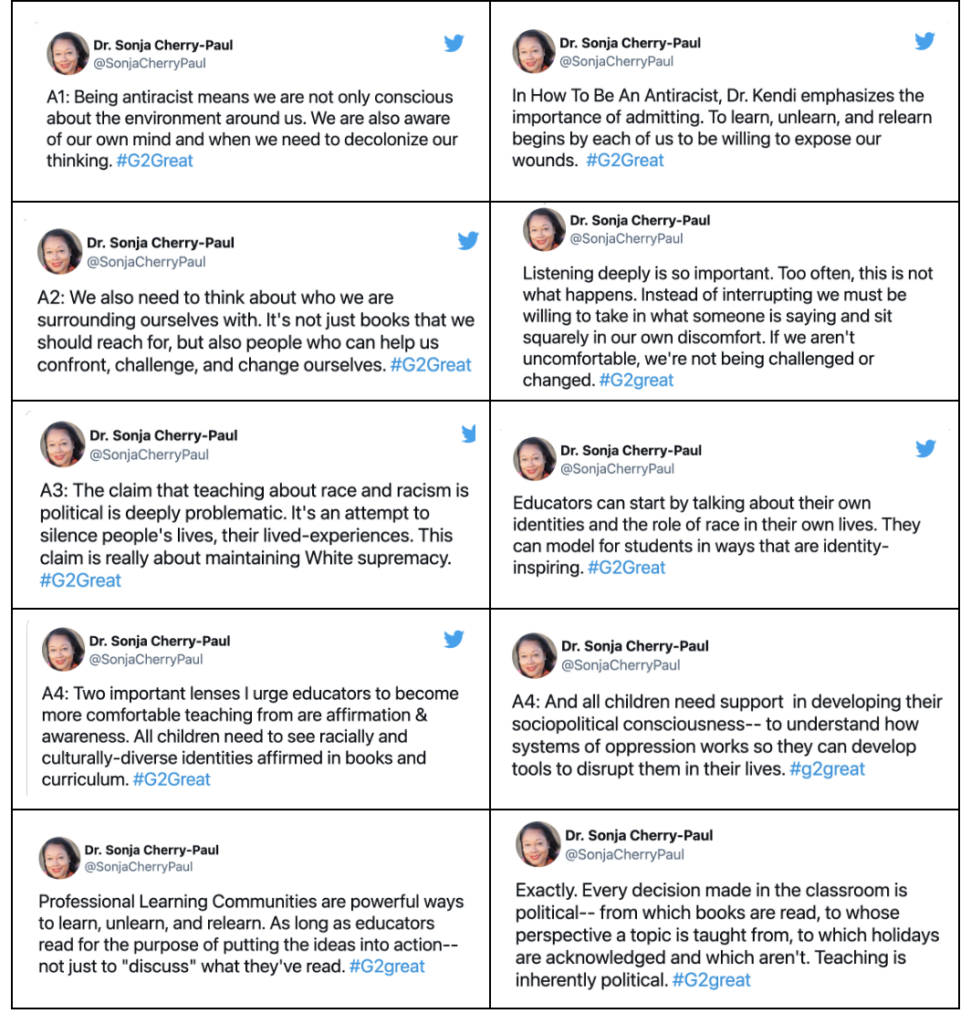
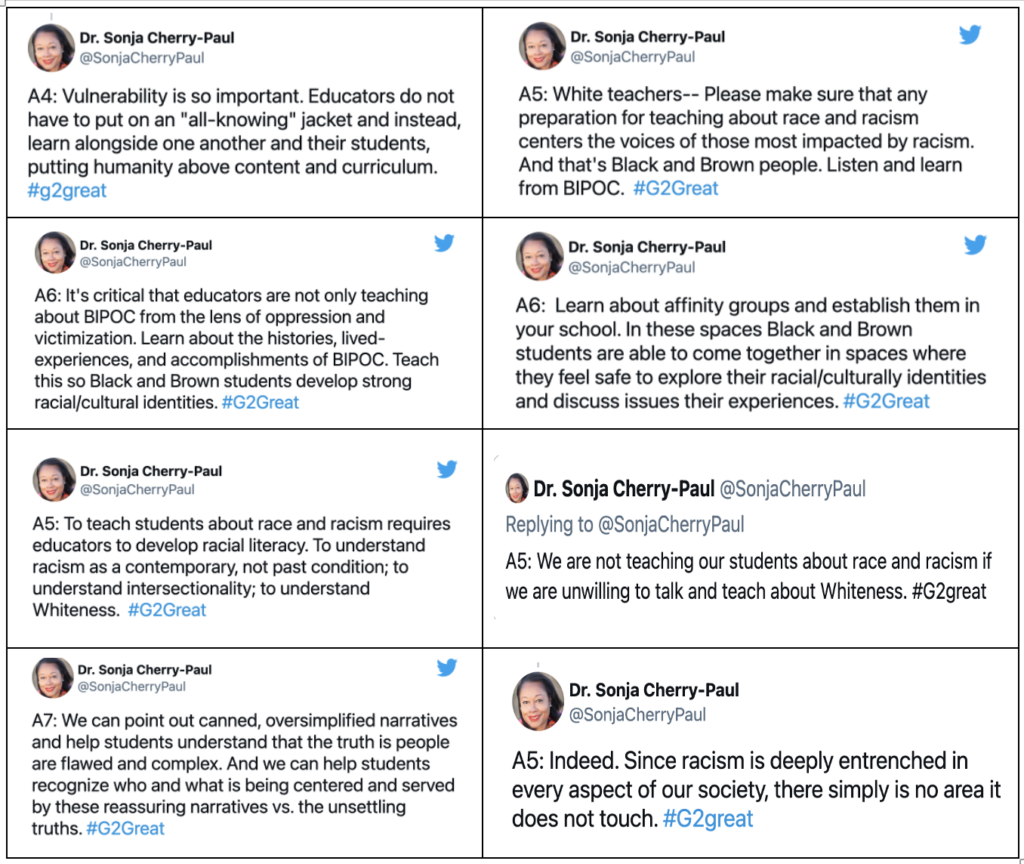
MY CLOSING THOUGHTS
On the morning after a full read of Stamped, I reached for my copy to reread Sonja’s wisdom but then I decided to quickly check my email first. At the top of my emails was a post by Diane Ravitch with the headline: Oklahoma state officials say It’s “Racist” to Teach About “Racism.” I live in Oklahoma, in fact the very city where The Tulsa Race Massacre took place in 1921. Sonja’s words had filled me with renewed hope and possibility. But as I stared at the words of ignorance on my computer screen, I had an overwhelming sense of shame to live in my own state.
After spending several minutes pondering the tragedy of what is all too common in our schools these days and the stark reality of racism everywhere we turn, I found solace for the unrelenting ignorance that won’t let go with Sonja’s words on page 5. My spirits lifted when I thought about how Sonja defined “antiracist” for her young (and yes, much older) readers in such a powerful way:

I thought about the hope and beauty in these words but also sadness for the love that is sorely missing in the world. I realized that the world cannot change until we are all willing to stand in solidarity and fight this ignorance in any way we can. I wondered if that begins with the introspective courage to admit that we have far to go personally. As I read the history of racism and antiracism from the 1415 “Great Big Lie” to present day, I was disappointed how little I knew. While this realization awakened a desire for change, I couldn’t shake the shame of not knowing. I had built a glass house around my whiteness shielding me from uncomfortable events simply because I had not lived them. But as I wrapped my fingers lovingly around Stamped as I had so many times in recent days, I recalled three words Sonja wrote in large capital letters:
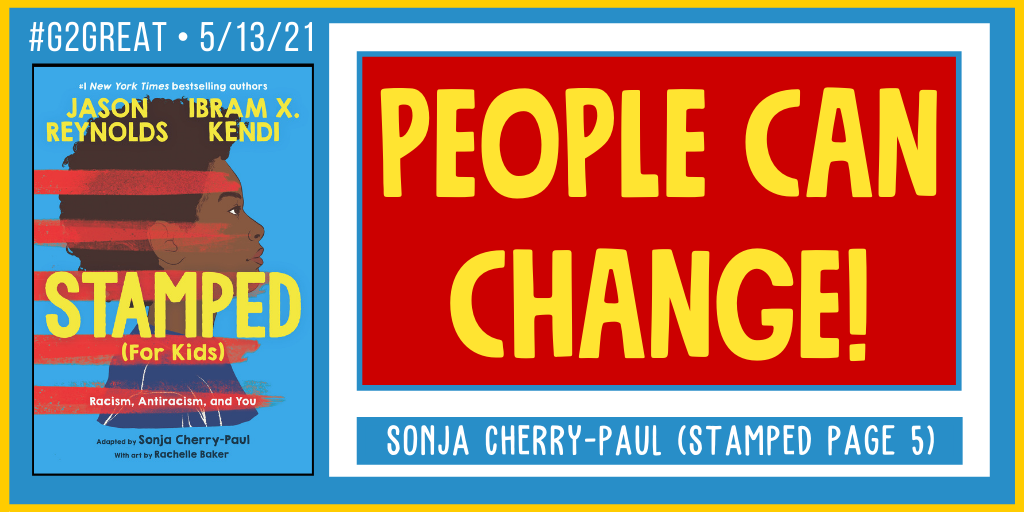
Those three words did not absolve my lack of awareness, but it did give me renewed hope: hope for myself, hope for others, hope for the world inspired by the knowledge of those who read Sonja’s beautiful book and share it with children they love. Sonja’s book is filled with invitations to change. She kept her promise to take readers on a race journey from then to now so that we may be part of writing the next chapter. She asks us to envision an “Antiracist Future” in her closing letter to kids on page 137. She reminds us that Stamped is “a start, not a finish” and that we can craft our journey to antiracism as we read, learn, talk and act in support of this journey. Above all, Sonja brings her words on page 7 to life on every page across her book. And it is these two words that I return to as I close this post and I will carry with me every day.

We are so grateful that Sonja graced our #G2great chat with her wisdom and gave us a book that will provide the heart fuel we need to engage in this important personal and collective journey. I can’t think of a better way to end this post than by returning to Sonja’s hopes for Stamped as each of us consider our own next steps toward an antiracist future.
What are your BIG takeaways from your book that you hope teachers will embrace in their teaching practices?
I hope teachers will read SFK and see a clear pathway for teaching about race, racism, and antiracism. I hope educators will embrace racial literacy as a necessary part of their teaching practices and that SFK is used to support this work. It’s important for teachers to understand that we truly cannot heal as a nation until we air our wounds and face the truth. And I hope that they see this work as urgent, necessary work as they teach young people in order for us to realize an antiracist future.
Thank you, Sonja!
LINKS
Dr. Sonja Cherry-Paul: Using ‘Stamped (For Kids)’ to Have Age-Appropriate Discussions About Race
Dr. Sonja Cherry-Paul Letter to Young Readers: Stamped (For Kids) — Our Story
#LBYRExtraCredit Presents: Stamped (For Kids) webinar with Dr. Ibram X. Kendi, Dr. Sonja Cherry-Paul and Julia Torres
From diversebooks.org: Read an Excerpt From Stamped (For Kids) By Jason Reynolds and Ibram X. Kendi by Alaina Lavoie
Teaching Guide for the first two Stamped in the series with Sonja assuming the role of curriculum developer. NOTE: A Stamped (For Kids) guide will be out this summer